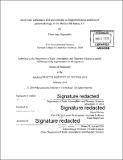| dc.contributor.advisor | David McGee. | en_US |
| dc.contributor.author | Steponaitis, Elena Anne | en_US |
| dc.contributor.other | Massachusetts Institute of Technology. Department of Earth, Atmospheric, and Planetary Sciences. | en_US |
| dc.coverage.spatial | n-us-ut | en_US |
| dc.date.accessioned | 2016-06-22T17:51:59Z | |
| dc.date.available | 2016-06-22T17:51:59Z | |
| dc.date.copyright | 2016 | en_US |
| dc.date.issued | 2016 | en_US |
| dc.identifier.uri | http://hdl.handle.net/1721.1/103248 | |
| dc.description | Thesis: Ph. D., Massachusetts Institute of Technology, Department of Earth, Atmospheric, and Planetary Sciences, 2016. | en_US |
| dc.description | Cataloged from PDF version of thesis. | en_US |
| dc.description | Includes bibliographical references. | en_US |
| dc.description.abstract | Precisely dated terrestrial paleoclimate records are indispensable for understanding how different regions respond to global-scale climate variability. Here, we focus on developing precisely dated records from the Bonneville Basin, a large basin in the eastern U.S. Great Basin. This region is known to have been highly sensitive to hydroclimate changes during the past glacial period; closed-basin lakes in this region have been studied for over a century. We present lake and speleothem records from the Bonneville Basin that are anchored by high-precision U-Th ages. Deep-lake carbonates are deposits that form beneath the surface of lakes in crevices and protected spaces. We explore these deposits as an archive of past hydrological change in the Bonneville Basin. Deep-lake carbonates deposits were collected from varying elevations in the basin and microsampled for U-Th dating. The results of this work improve constraints on existing lake level information for Lake Bonneville. Additionally, we present [delta]234U data from these carbonates that records changes in weathering, and by extension, hydrology, in the Bonneville Basin. 87Sr/86Sr ratios of deep-lake carbonates reflect relative changes in fluvial input between the northern and southern sub-basins of the Bonneville Basin, allowing for the reconstruction of past precipitation patterns. This record shows that there were distinctly different patterns of atmospheric circulation over the Bonneville Basin during Heinrich Event 2 and the Last Glacial Maximum. Finally, we present records Mg/Ca ratios and [delta]13C values of speleothems from Lehman Caves, NV, located on the western edge of the Bonneville Basin. These records suggest that the onset of mid- Holocene drying in the Great Basin was at 8.2 ka, coincident with the collapse of the Laurentide Ice Sheet. | en_US |
| dc.description.statementofresponsibility | by Elena Anne Steponaitis. | en_US |
| dc.format.extent | pages | en_US |
| dc.language.iso | eng | en_US |
| dc.publisher | Massachusetts Institute of Technology | en_US |
| dc.rights | M.I.T. theses are protected by copyright. They may be viewed from this source for any purpose, but reproduction or distribution in any format is prohibited without written permission. See provided URL for inquiries about permission. | en_US |
| dc.rights.uri | http://dspace.mit.edu/handle/1721.1/7582 | en_US |
| dc.subject | Earth, Atmospheric, and Planetary Sciences. | en_US |
| dc.title | Deep-lake carbonates and speleothems as high-resolution archives of paleohydrology in the Bonneville Basin, UT | en_US |
| dc.type | Thesis | en_US |
| dc.description.degree | Ph. D. | en_US |
| dc.contributor.department | Massachusetts Institute of Technology. Department of Earth, Atmospheric, and Planetary Sciences | |
| dc.identifier.oclc | 951626510 | en_US |
